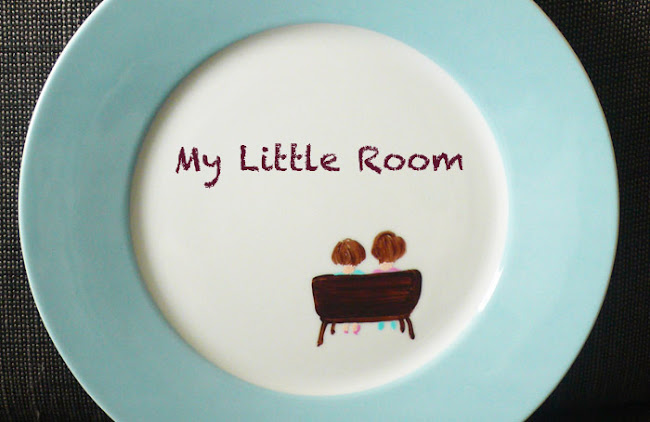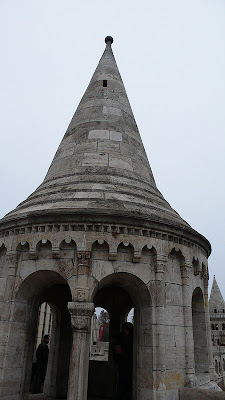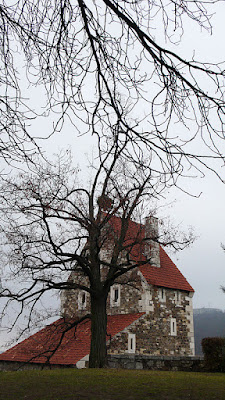我用龜速的散步加寫生的行程,終於到達了布達城堡。
I walked at a turtle's pace. Plus my sketching itineraries, it took me a whole morning to get to Buda Castle.
最近每看到好風景或好紀念品,都很想全部寄給我最愛的家人,所以我在郵局畫了一張明信片寄給我們家的爸爸媽媽。
Now whenever I see something beautiful, I am overwhelmed with the strong longing to send it all to my beloved family. I drew a postcard of the dome of the palace and mailed it to my dad and mom.
城堡現今有203間房間,也兼作布達佩斯歷史博物館和國家藝廊。
The castle has 203 rooms, housing the Budapest Historical Museum and the National Gallery.
馬提亞斯溫泉 /Matthias Fountain
這組雕像的中心人物是馬提亞斯國王帶領的打獵團和旁邊被射殺的鹿。
The central figure is King Matthias Corvinus (1443-1490), his followers, hounds, and a killed deer.
走來走去對於皇宮前的騎士雕像很有興趣,雖然天寒地凍的,我還是把速寫本拿出來,站在那兒一陣子,發現我對於宣傳這座雕像很有力,因為越來越來人停下來和它合照。剛才上網查了一下,騎士的背景非常了不得,他是對抗土耳其人戰無不勝的薩佛伊公國歐根親王,是歐洲近代史上最成功的軍事指揮之一,在維也納的王朝宮庭裡擔任軍事最高階。
After walking around, I was highly interested in this equestrian statue. Though it was really freezing, I still took out my sketchbook without hesitation. Having stood in front of it for a while, I realized my presence had helped to promote it because more and more tourists paused to take a photo with it. I looked up the background of the sculpture a moment ago. The horse rider is actually Prince of Eugene of Savoy (1663-1736). He was known for defeating the Ottoman armies. He was one of the most glorious military commanders in European modern history, rising to the highest office at the Imperial court in Vienna.
路邊有玩射箭一次五百福林的小攤子。
There was a stall offering service for tourists to try their hand at shooting arrows opposite the palace 500 forints per time.
城堡區的街道。
The streets in the Castle District.
紀念品店前的大玫瑰。
the huge rose in front of a souvenir shop.
某家店門前的招牌設計。
The emblem design of a certain shop.
小帥哥在製作匈牙利點心煙囪蛋糕。
The cute boy was making the Hungarian pastry chimney cake (kurtoskalacs).
照片取自於 / photo taken from :
http://www.chew.hu/kurtoskalacs_maker_awarded_by.html
因為中午吃了個很大很甜的蘋果肉桂捲,我沒有屈服在小帥哥的美色之下,所以從別人網站借了張圖片給讀者們瞧瞧,我的旅遊記錄越來越專業了。
Because I had a huge and sweet apple cinnamon roll for lunch, I didn't succumb to the beauty of the boy. Thus I borrowed a photo from the website of a bakery in Debrecen, the second largest city in the east of Hungry, for my reader to have a picture. See, my travel blog is getting to be professional.
雖然開始下雨,但是我前一天找不到的馬提亞斯教堂就在眼前!
Though it had started to rain, I was very happy to find Matthias Church, which I had had difficulty getting to, in front of my eyes!
馬提亞斯教堂建於十三世紀,也是以上面提到的馬提亞斯國王命名。他在任四十二年(1458-1490),對藝術大力支持。之後土耳其人於1541年入侵,對內部做變更。1686年,土耳其政權被推翻,當地建築師試著加入當時流行的巴洛克元素,但並不成功。十九世紀晚期,建築師Frigyes Schulek整修教堂,復原之前的哥德元素,並重建屋頂,採用現今可見的鑽石花紋。
Matthias Church was first built in the 13th century, named after King Matthias Corvinus, who was mentioned earlier in this post. During his 42-year-long reign from 1458 to 1490, he was a great patron of art. When the Turks captured Buda in 1541, they made some change to the interior frescoes. In 1686, after the Turks were overthrown, the local architects tried to add then popular Baroque elements, but it wasn't considered a successful attempt. In the late 19th century, the architect Frigyes Schulek renovated the church to its original splendor and uncovered the Gothic elements. He also added the diamond patterns to the roof, which can still be seen today.
馬提亞斯教堂旁就是漁夫堡,也是由上一段提到的建築師Frigyes Schulek設計,建於1905年。因為當時位於漁村旁便以此為名。有七座塔,代表西元896年來到匈牙利的七個馬札爾族。這裡是遠眺布達佩斯城最好的景點,一切盡收眼底。
Next to Matthias Church is Fisherman's Bastion, which was also designed by the afore-mentioned architect Frigyes Schulek. It was completed in 1905. The name comes from the origin that it sits in the neighborhood of a fisherman's town. There are seven towers, each representing a Magyar tribe that came to Hungary in 896. This is one of the best sites for overlooking the whole city.
下山的時候,雨下得有點大,階梯上有兩名老人拉琴拉得很用力,但不是很專業的演出,我覺得他們肯工作也算努力,隨著身邊的人潮丟了幾個銅板,想不到剛走幾步,音樂就嘎然而止,回頭一看,原來遊客一下散去,他們倆也放下樂器休息,唉,匈牙利人‧‧‧
When I was going down the hill, it rained a little bit heavily. Two old men were playing the fiddles really hard, though not very professionally. Moved by their diligence, I threw some coins along with other tourists. However, as I took some steps, the music stopped abruptly. As I turned back, I realized that they did so because all the tourists had gone and they felt like taking a break with no one around. Ah, Hungarians...
























































